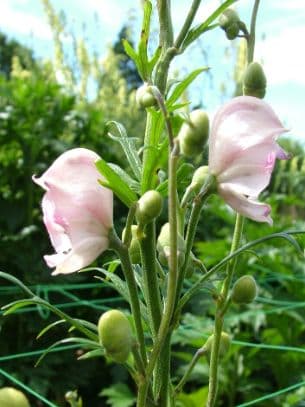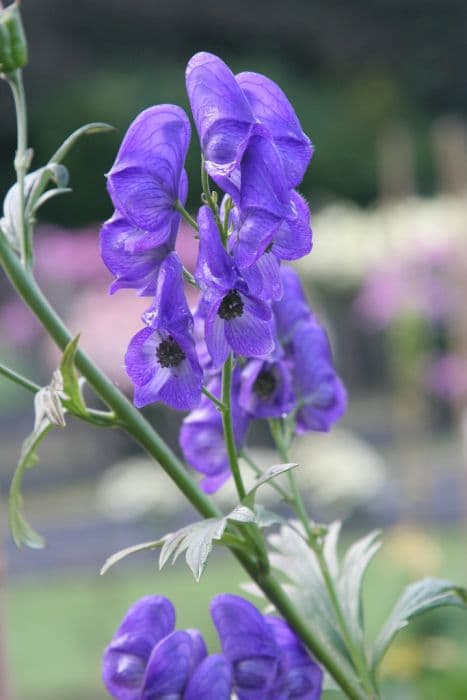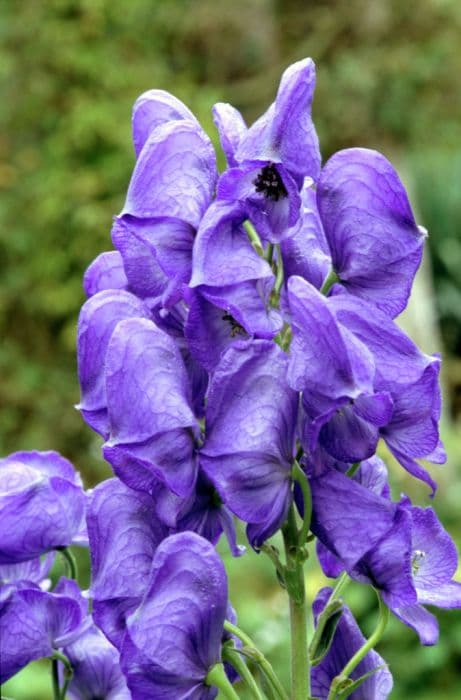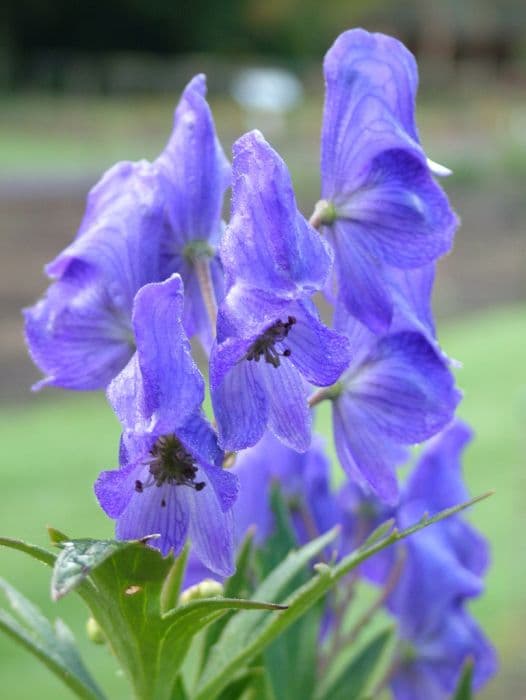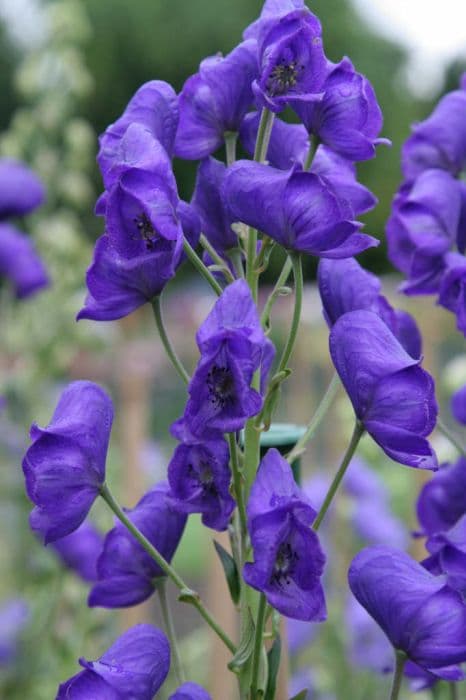Larkspur Delphinium 'Our Deb'

ABOUT
Delphinium 'Our Deb' is a striking perennial that features a spectacular display of flowers. This plant is characterized by its tall spires of blooms that come in a vibrant range of colors, typically shades of blue, lavender, purple, or white. Each individual flower is trumpet-shaped and arranged in a dense, elongated cluster along the central stalk. The flowers are often accentuated with a contrasting lighter or darker bee, which is the central part of the blossom that often appears in a different color. The foliage of Delphinium 'Our Deb' is equally attractive, with deeply cut, palmate leaves that are a lush green color. The leaves are divided into narrow lobes, which spread out like fingers and have a slightly fuzzy texture. The overall form of the plant is upright and stately, with multiple flowering stems that rise above the clump of basal leaves. The majestic presence of Delphinium 'Our Deb' in the garden adds a touch of elegance and vertical interest. The blooms are also popular for their use in cut flower arrangements, where their height and vivid hues can be particularly striking. This plant thrives in a well-drained soil environment with a preference for cooler temperatures and shelter from strong winds. It is often seen adorning cottage gardens, borders, and is a favorite among pollinators such as bees and butterflies.
About this plant
 Names
NamesFamily
Ranunculaceae.
Synonyms
Larkspur, Delphinium.
Common names
Delphinium 'Our Deb'.
 Toxicity
ToxicityTo humans
The plant known as Larkspur is toxic to humans. Ingesting parts of the plant can lead to a range of symptoms, including nausea, vomiting, abdominal pain, muscular weakness, and potential paralysis due to the presence of toxic alkaloids such as delphinine. Severe poisoning can cause cardiac complications and respiratory paralysis, which can be fatal.
To pets
Larkspur is also toxic to pets, which can experience symptoms of poisoning like drooling, abdominal pain, vomiting, diarrhea, muscular weakness, convulsions, and even respiratory or cardiac failure upon ingestion. The severity of symptoms varies depending on the amount consumed. It is particularly dangerous to horses, with even small amounts potentially causing serious health issues or death.
 Characteristics
CharacteristicsLife cycle
Perennials
Foliage type
Deciduous
Color of leaves
Green
Flower color
Blue
Height
4-6 feet (1.2-1.8 meters)
Spread
2-3 feet (0.6-0.9 meters)
Plant type
Herb
Hardiness zones
3-7
Native area
Varies
Benefits
 General Benefits
General Benefits- Attracts Pollinators: Delphiniums are popular among bees, butterflies, and hummingbirds, promoting pollination in the garden.
- Height Interest: 'Our Deb' can add vertical interest to gardens, reaching heights of 4-6 feet, and serving as a backdrop to lower-growing plants.
- Vibrant Colors: With its striking blue flowers, Delphinium 'Our Deb' helps create a vivid color palette in a garden setting.
- Cottage Garden Charm: Delphiniums are quintessential cottage garden plants, adding an element of traditional charm and romance.
- Seasonal Screen: Taller varieties like 'Our Deb' can be used to create a temporary green screen during the growing season.
- Cut Flowers: The stems of 'Our Deb' are sturdy and long, making them excellent for cut flower arrangements.
- Perennial Growth: As a perennial, it will return for several years, reducing the need for replanting annually.
 Medical Properties
Medical PropertiesThis plant is not used for medical purposes.
 Air-purifying Qualities
Air-purifying QualitiesThis plant is not specifically known for air purifying qualities.
 Other Uses
Other Uses- Delphinium 'Our Deb' petals can be used to create natural dyes for fabrics, providing a range of hues from pale to deep blue.
- The tall and striking appearance of Delphiniums makes them suitable for theatrical stage designs, particularly in scenes aiming to evoke an outdoor setting.
- Because of their structural form, Delphiniums can be used in large-scale floral sculptures and art installations.
- Their height and sturdy stems allow Delphiniums to be used as natural supports for lighter-weight, trailing plants in mixed plantings.
- Dried Delphinium blooms can be incorporated into potpourri mixes for a subtle fragrance and bursts of color.
- In some cultures, Delphinium petals are scattered in ceremonies to symbolize joy and goodwill due to their vibrant color.
- The flower spikes of Delphiniums can be used as natural pointers or markers in educational gardens to highlight areas or particular plants.
- Pressed Delphinium flowers can be used in crafting, such as in making bookmarks, greeting cards, or in scrapbooking.
- The distinctive look of Delphinium spires can inspire elements of design in fashion, such as embroidery patterns on fabrics or in accessories.
- Delphinium 'Our Deb' may be used in professional photography for portrait backdrops, providing a picturesque setting with its tall, colorful blooms.
Interesting Facts
 Feng Shui
Feng ShuiThe Delphinium is not used in Feng Shui practice.
 Zodiac Sign Compitability
Zodiac Sign CompitabilityThe Delphinium is not used in astrology practice.
 Plant Symbolism
Plant Symbolism- Protection: Delphiniums are often associated with protection due to their tall, towering form which historically was believed to guard and protect against dangers.
- Openness to New Experiences: The wide bloom of the flower signifies a readiness to embrace new challenges and opportunities.
- Celebration: The bright and bold colors of delphiniums are reminiscent of fireworks, which symbolize celebration, making them popular for commemorating significant events.
- Lightness and Levity: Delphiniums carry a sense of joy and playfulness, often symbolizing an overall lightness of being and a positive outlook on life.
- Ardent Attachment: The flower is commonly used to represent strong bonds of love, suggesting an intense and passionate attachment between people.
 Water
WaterFor Delphinium 'Our Deb', commonly known as larkspur, it is essential to keep the soil consistently moist but not waterlogged. During the growing season, water the plant once or twice weekly, applying approximately 1 to 1.5 gallons of water each time, depending on weather conditions. Make sure to water deeply to encourage root growth and avoid wetting the foliage to reduce the risk of fungal diseases. During hot spells or drought, you may need to water more frequently to maintain the moisture level, while during rainy periods, reduce the watering accordingly.
 Light
LightLarkspur thrives in full sun to partial shade. The best light conditions for Delphinium 'Our Deb' are a spot that receives at least 6 hours of direct sunlight daily. If you are in a particularly hot climate, providing afternoon shade can help protect the plant from intense heat and prevent scorching of the leaves.
 Temperature
TemperatureLarkspur prefers cooler climates and can generally tolerate temperatures as low as 40 degrees Fahrenheit and as high as 85 degrees Fahrenheit. The ideal temperature range for Delphinium 'Our Deb' is between 50 and 75 degrees Fahrenheit. Extreme heat or sudden temperature swings can stress the plant, so providing a stable environment is key for its growth.
 Pruning
PruningPruning Delphinium 'Our Deb' helps to promote vigorous growth and improves air circulation, reducing disease risk. Deadhead spent flowers to encourage a second bloom, and cut back stems after flowering to within a few inches of ground level in late fall. Prune damaged or dead stems as necessary, and in early spring, trim the plant to help shape it and remove any old or dead growth from the previous year.
 Cleaning
CleaningAs needed
 Soil
SoilLarkspur 'Our Deb' thrives in well-draining, fertile soil with good organic matter content. The best soil mix would be one part loam, one part peat moss or compost, and one part perlite or sharp sand to ensure drainage. The soil pH should be slightly alkaline, around 7.0 to 7.5, which is ideal for this plant to absorb nutrients properly.
 Repotting
RepottingLarkspur 'Our Deb' doesn't generally require frequent repotting as it is often grown as an annual. However, if grown as a perennial, repotting might be needed every 2 to 3 years in the spring to refresh the soil and provide room for growth.
 Humidity & Misting
Humidity & MistingLarkspur 'Our Deb' does well in average garden humidity conditions. It prefers outdoor settings where it can benefit from natural air circulation rather than high indoor humidity, which can lead to fungal diseases.
 Suitable locations
Suitable locationsIndoor
Grow in bright light, cool area; keep soil moist.
Outdoor
Full sun, fertile soil, protect from strong winds.
Hardiness zone
3-7 USDA
 Life cycle
Life cycleDelphinium 'Our Deb', commonly known as larkspur, starts its life as a seed, needing a cold period to break dormancy before germination in the spring. Upon sprouting, the seedling establishes roots and a rosette of basal leaves, which will fuel the plant's growth. From there, it enters the vegetative stage, where the stem elongates, and its characteristic deeply lobed leaves develop. As it matures, the larkspur enters the flowering stage, usually in early summer, producing tall spikes adorned with a series of colorful flowers that are highly attractive to pollinators like bees and butterflies. Following pollination, the plant sets seeds, which are contained in small capsules that disperse when mature, allowing for the propagation of new plants. In autumn, the larkspur enters dormancy, with the top growth dying back and the plant relying on its root system to survive the winter, repeating its life cycle the following year.
 Propogation
PropogationPropogation time
Spring-Early Summer
The Delphinium 'Our Deb', commonly known as Larkspur, is typically propagated through seed sowing. The best time to sow Delphinium seeds is in late winter to early spring when they can be started indoors 8 to 10 weeks before the last expected frost date. For successful germination, maintain a soil temperature of 65 to 75 degrees Fahrenheit (18 to 24 degrees Celsius). The seeds should be sprinkled onto the surface of a well-draining seed starting mix and lightly covered with soil as they require darkness to germinate. Keep the soil consistently moist but not waterlogged. Seedlings will usually appear within 2 to 3 weeks, and after the threat of frost has passed, they can be transplanted outdoors into well-prepared garden beds.

